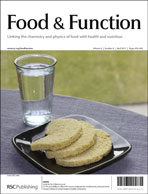Dietary spices as beneficial modulators of lipid profile in conditions of metabolic disorders and diseases
Abstract
Spices are valued for their medicinal properties besides their use as food adjuncts to enhance the sensory quality of food. Dietary garlic, onion, fenugreek, red pepper, turmeric, and ginger have been proven to be effective hypocholesterolemics in experimentally induced hypercholesterolemia. The hypolipidemic potential of fenugreek in diabetic subjects and of garlic and onion in humans with induced lipemia has been demonstrated. Capsaicin and curcumin – the bioactive compounds of red pepper and turmeric – are documented to be efficacious at doses comparable to usual human intake. Capsaicin and curcumin have been shown to be hypotriglyceridemic, thus preventing accumulation of fat in the liver under adverse situations by enhancing triglyceride transport out of the liver. Capsaicin, curcumin, fenugreek, ginger, and onion enhance secretion of bile acids into bile. These hypocholesterolemic spices/spice principles reduce blood and liver cholesterol by enhancing cholesterol conversion to bile acids through activation of hepatic cholesterol-7α-hydroxylase. Many human trials have been carried out with garlic, onion, and fenugreek. The mechanism underlying the hypocholesterolemic and hypotriglyceridemic influence of spices is fairly well understood. Health implications of the hypocholesterolemic effect of spices experimentally documented are cardio-protection, protection of the structural integrity of erythrocytes by restoration of membrane cholesterol/phospholipid profile and prevention of cholesterol gallstones by modulation of the cholesterol saturation index in bile.


 Please wait while we load your content...
Please wait while we load your content...